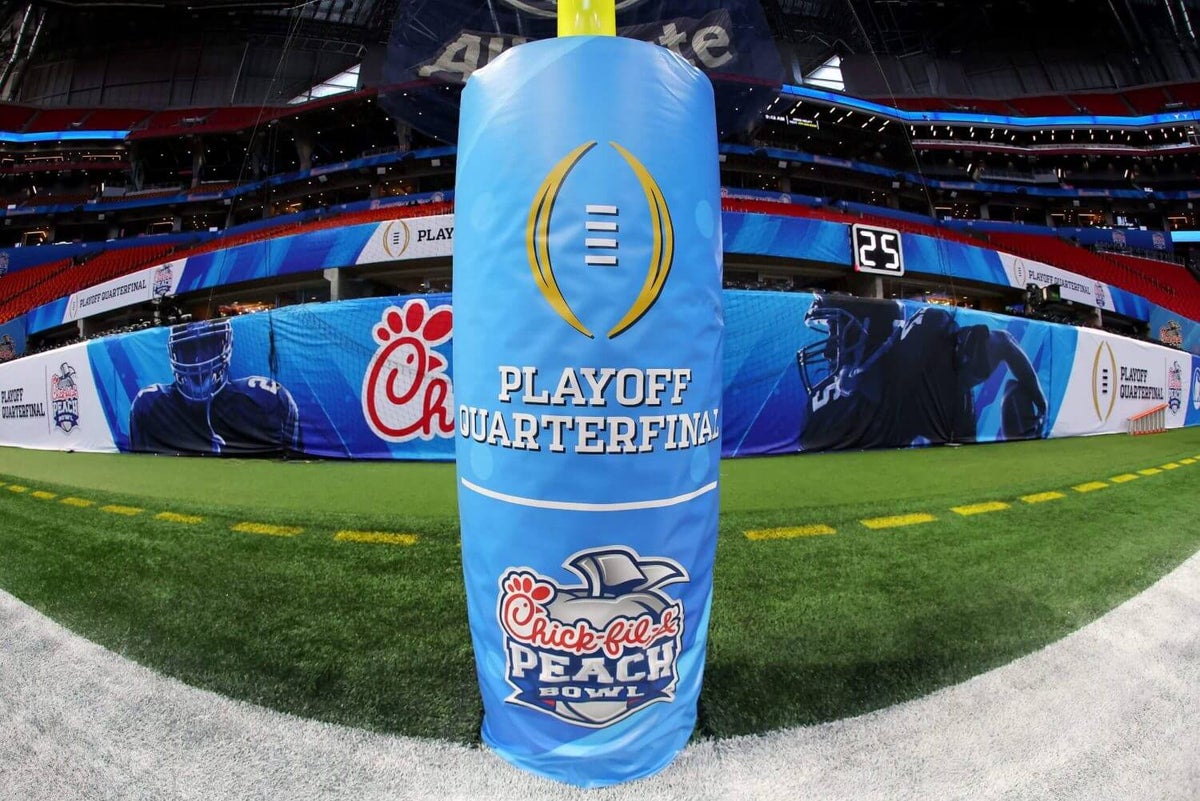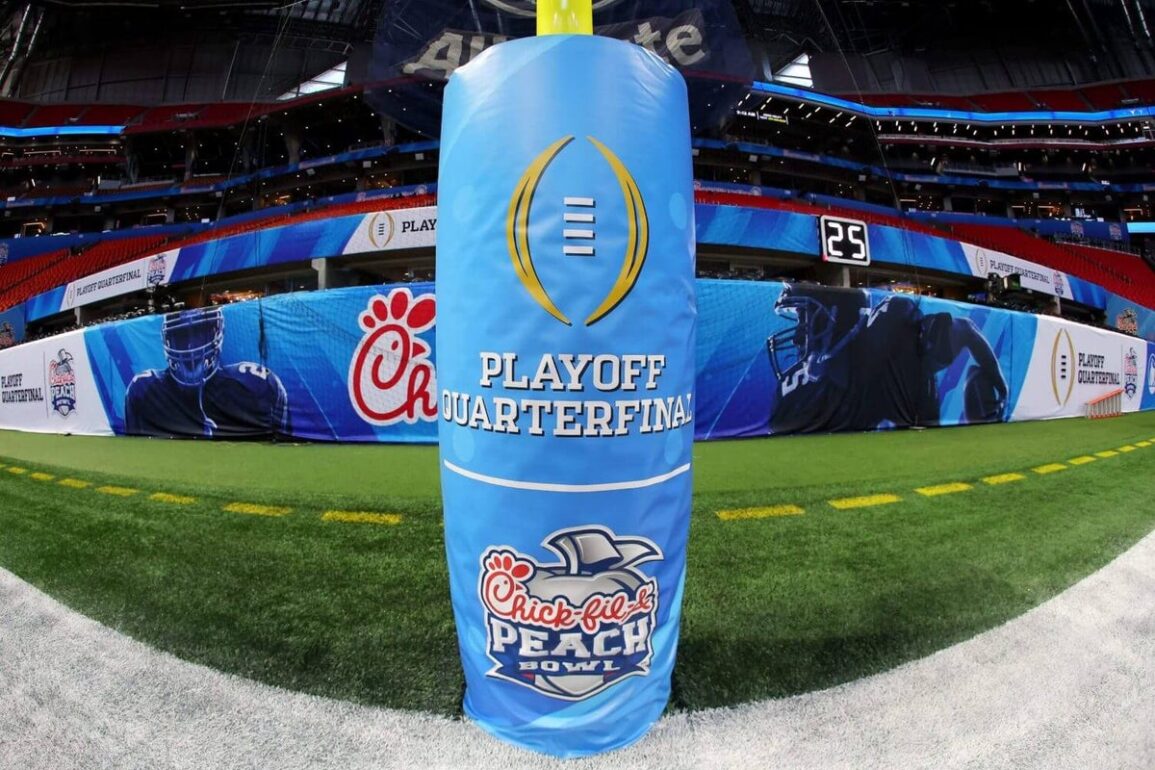
As the conference commissioners overseeing the postseason debate what’s next for the College Football Playoff, an expansion of the 2026 bracket has practically been a foregone conclusion for months.
The initial focus of the discussions was a move from 12 to 14 teams, with a 16-team field a fringe possibility, mostly because of one vexing issue: When would four more early-round Playoff games happen?
Advertisement
Now, 16 seems to be the sweet spot because access trumps everything else when it comes to the Playoff. Just like when CFP architects jumped from four to 12 teams during the initial expansion discussions, going bigger is usually an idea everyone can support.
With Big Ten commissioner Tony Petitti seemingly dug in on getting four automatic qualifiers (AQs) for his conference — and SEC commissioner Greg Sankey not forcefully pushing back — the group’s other members appear to be building a format around those bids as best they can.
“Everyone else in the room feels like multiple AQs for conferences make it an invitational,” said one person involved in the discussions.
The Athletic spoke to seven people involved in or briefed on the CFP management committee’s talks over the last five months. They spoke on condition of anonymity because no one has been authorized to speak publicly about what has turned into another drawn-out and increasingly complicated CFP negotiation.
“It’s being held hostage,” another person said.
The full management committee, which includes the 10 Football Bowl Subdivision conference commissioners and Notre Dame athletic director Pete Bevacqua, is set to connect again later this week for a video conference call. The sources say it is possible the committee could finally decide how schools are seeded for this season’s 12-team Playoff — namely, a change to seeds that match the selection committee’s rankings, instead of guaranteed byes for conference champions.
Last week, ACC commissioner Jim Phillips indicated he could support straight seeding. The current CFP agreement requires unanimous approval within the management committee to enact any format changes.
The committee’s next in-person meeting, its fourth since Ohio State beat Notre Dame to win the first 12-team playoff in January, is scheduled for mid-June. While deadlines have mostly been theoretical when it comes to CFP decisions over the years, all participants feel it’s ideal to set a format for the 2026 season before the 2025 season begins.
Advertisement
Ultimately, determining the Playoff’s format for 2026 and beyond will fall to the leaders of the Power 4 conferences: Petitti, Sankey, Phillips and the Big 12’s Brett Yormark. A gathering of those four in New York earlier this month fueled the idea of a 16-team field, as the Big 12 and ACC look to protect their access and brands.
As far back as spring 2024, the Big Ten floated the idea of a 14-team CFP that included four AQs for the Big Ten and SEC, two for the Big 12 and ACC, one for the highest-ranked champion from the six other FBS conferences and one spot that would essentially be an at-large bid. The at-large spot creates a path for independent Notre Dame to qualify by earning a high enough ranking from the selection committee.
Sankey and SEC administrators have supported securing automatic access, too, and despite skepticism from the rest of the management committee, Petitti has remained staunchly in favor. At a joint meeting between the SEC and Big Ten in New Orleans in February, Petitti talked about the connection between the path to the Playoff and the regular season.
“How you qualify for the postseason impacts the regular season or how you perceive you qualify for the postseason, what factors you think are important,” Petitti said. “I think that informs the way you think about the regular season, they’re just downstream. They’re all tied together, right?”
Petitti wants a path that relies less on the subjective decisions of the selection committee. Right now, his opinion matters more than most.
The new CFP agreement that goes into effect in 2026 gives far more power to the Big Ten and SEC to determine the format’s future. It also guarantees those conferences about 58 percent of CFP revenue over the six-year, $7.8 billion deal with ESPN that also kicks in next year.
Advertisement
There has been some sentiment among the full group that the potential for public and political backlash would discourage the Big Ten and SEC from moving forward with an AQ-heavy CFP model. ESPN officials have also advised caution when it comes to expansion and AQs, for fear the changes could negatively impact the regular season and the Playoff.
Still, the AQs remain on the table, and the number of teams continues to grow.
Both the Big Ten and SEC have talked internally about using the AQs to reimagine their championship weekends, which would potentially keep more of their teams in the CFP race deeper into the season.
“How do we make sure our fans are engaged?” Texas A&M AD Trev Alberts told The Athletic in April. Alberts was previously at Nebraska in the Big Ten before taking over at the SEC school last year.
Petitti has pitched the Big Ten athletic directors on creating two championship weekend play-in games to determine which of the league’s teams receive at least two of those automatic bids. Championship game participants would qualify for two AQs, while teams ranked third through sixth would face off for the other two.
The Big 12 and ACC, with fewer AQs, would be more limited in how they could expand their championship weekends. More importantly, having half as many AQs as the Big Ten and SEC creates a huge perception problem for the leagues, sending a message to both recruits and potential business partners that the ACC and Big 12 are half as good as college football’s top tier.
Growing the field to 16 would open up a possible alternative to the 4-4-2-2-1-1 plan by giving the Big 12 and ACC an extra auto-bid, but with stipulations. The Big 12 and ACC’s third AQs in a 4-4-3-3-1-1 model would have to reach a minimum selection-committee ranking — possibly No. 18 — to make the Playoff. If not, those would become at-large spots, open to teams from any conference.
Advertisement
The qualifiers might only apply to the ACC and Big 12, but nothing is firm right now, especially the matter of when to stage any additional Playoff games.
“Even if we go to 14, we’re going to run into challenges with where to play the games,” a third person said.
A 14-team bracket would have removed two first-round byes and added two games to the first weekend of the Playoff, which is the third weekend in December. That’s two weeks after conference championship weekend, giving every team involved in the CFP at least one week off and leaving Army and Navy the second weekend of December all to themselves, as has become tradition for the service academy rivalry.
There is no obvious spot for two more games on the opening weekend that would provide a desirable, exclusive TV window. Last year, Notre Dame-Indiana kicked off the first 12-team CFP on a Friday night. A tripleheader followed on Saturday, starting at noon ET and competing directly with two late-season NFL games.
In a 16-team bracket, one alternative is to eliminate byes and play eight first-round games over that weekend. That approach is highly unlikely to advance. More likely, the CFP would look to start a week earlier, on what has traditionally been Army-Navy weekend, with the four lowest seeds (13 through 16) playing their way into the second weekend’s six-game bracket.
The top two seeds would still get byes into the quarterfinals.
“You can play the games anytime, but there’s no way to maximize the TV audience,” a fourth person said.
Also notable: The CFP’s new contract with ESPN does not require the network to pay for more inventory beyond the 11 games required for a 12-team field.
All those issues appear to be secondary. As the haggling over access continues, one thing seems clear when it comes to the CFP: Adding more teams will be part of the resolution.
(Photo: Kevin C. Cox / Getty Images)
This post was originally published on this site be sure to check out more of their content.









